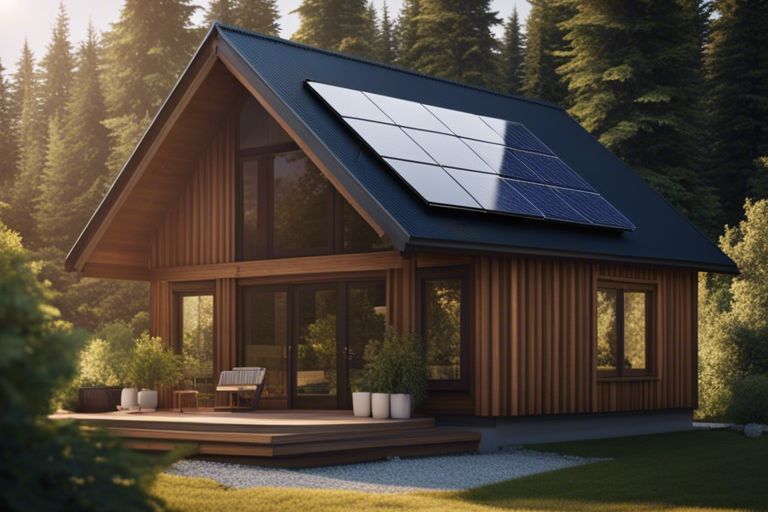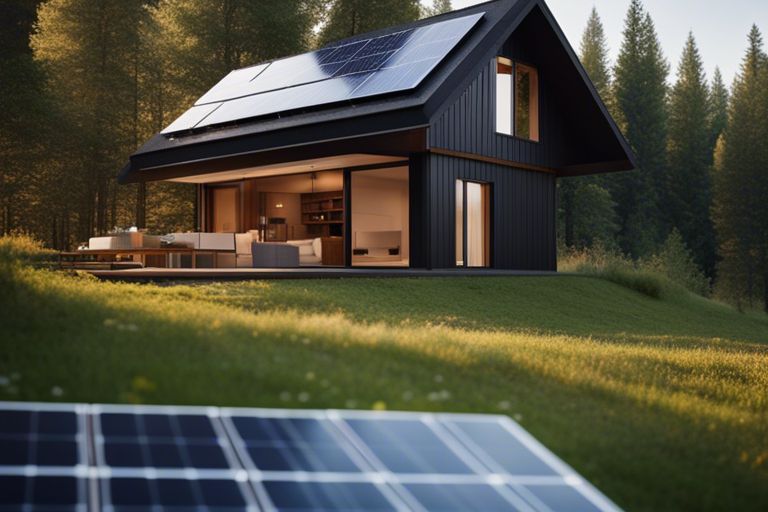When going off-grid, understanding how many solar panels you need to power your house is crucial for a successful setup. In this informative blog post, you will learn the factors that determine the number of solar panels required for your off-grid house. To calculate accurately, check out this detailed guide on How Many Solar Panels To Run A House Off Grid and make informed decisions for your energy needs.

Key Takeaways:
- Calculate your energy needs: Before determining the number of solar panels required, calculate your daily energy consumption to determine the size and capacity of the solar power system needed.
- Consider solar panel efficiency: Higher efficiency panels generate more electricity from the same amount of sunlight, requiring fewer panels to meet your energy needs.
- Consult a professional: For an accurate assessment of the number of solar panels needed to run your house off-grid, it is recommended to consult with a solar energy expert who can provide a customized solution based on your specific requirements.
Determining Your Energy Needs
To How many solar panels do I need to be off the grid? Start by calculating your daily energy consumption. This will help you determine the number of solar panels needed to meet your off-grid power requirements.
Calculating Your Daily Energy Consumption
With the help of your utility bills or using an energy monitoring device, you can track your daily energy consumption. Take note of the average kilowatt-hours (kWh) you use in a day. This information is crucial in determining the size of the off-grid solar power system you will need for your home.
Accounting for Variations in Energy Usage
Your energy usage may fluctuate depending on the season or your lifestyle. For example, you might use more energy in the summer for air conditioning or cooling systems. It’s vital to account for these variations when sizing your off-grid solar panel system to ensure you have enough power throughout the year.
Understanding these variations will help you design a solar power system that can efficiently meet your energy needs even during high usage periods. By carefully analyzing your energy consumption patterns, you can tailor your off-grid system to provide reliable power all year round.

Assessing Your Solar Resource
Evaluating Your Location’s Solar Irradiance
Any off-grid solar power system depends on the amount of sunlight your location receives. The solar irradiance in your area, which is the amount of sunlight that reaches a specific area, plays a crucial role in determining how many solar panels you will need to run your house off the grid. You can easily assess this by using online tools or consulting solar maps that provide data on average sunlight hours in your region.
Considering Shading and Obstructions
With solar panels, it’s crucial to consider any potential shading or obstructions that could affect their efficiency. Factors such as nearby buildings, trees, or even chimney shadows can impact the amount of sunlight your panels receive. Before installing solar panels, take note of any shading patterns throughout the day and year, as this will help you optimize the placement of your panels for maximum solar exposure.
Assessing the shading and obstructions at your location is crucial for maximizing the efficiency of your off-grid solar system. By ensuring that your solar panels are not obstructed by shading from trees or buildings, you can significantly increase your system’s energy production and ultimately reduce your reliance on the grid.
Sizing Your Solar Panel System
Calculating the Required System Size
Your first step in determining how many solar panels you need to run your house off the grid is to calculate the required system size. This involves analyzing your household’s energy consumption, which can be done by looking at your utility bills to determine your average daily or monthly usage. Once you have this information, you can calculate the number of kilowatt-hours you use per day or month.
Selecting the Right Solar Panel Type and Efficiency
On your journey to running your house off the grid with solar panels, selecting the right solar panel type and efficiency is crucial. You’ll want to consider factors such as monocrystalline, polycrystalline, or thin-film solar panels. Calculating the efficiency of a solar panel refers to the amount of sunlight the panel can convert into usable electricity. Higher efficiency panels may cost more initially but can be more space-efficient and cost-effective in the long run.
Your choice of solar panel type and efficiency will impact the overall performance and output of your off-grid solar system. If you have limited roof space or are looking to maximize energy production, higher efficiency panels may be the way to go. However, keep in mind that the right choice will depend on your specific needs and budget.
Considering Energy Storage Options
The Role of Batteries in Off-Grid Systems
Now, when planning to run your house off-grid with solar panels, you need to consider the role of batteries in your system. Batteries are imperative for storing excess energy generated by your solar panels during the day so that you can use it at night or when the sun isn’t shining. They act as a backup power source, ensuring a reliable supply of electricity when sunlight is limited.
Sizing Your Battery Bank
Considering the size of your battery bank is crucial when setting up an off-grid solar system. The capacity of your battery bank will determine how much energy you can store and use when your solar panels are not generating electricity. Factors such as your daily energy consumption, the number of days of autonomy you require, and the efficiency of your battery system will all play a role in determining the size of your battery bank.
The key to sizing your battery bank correctly lies in balancing your energy needs with the storage capacity of the batteries. You want to ensure that your batteries can meet your electricity demands during periods of low sunlight or inclement weather. It’s recommended to work with a professional to calculate the optimal size of your battery bank based on your specific household energy requirements.
Plus, it’s also imperative to consider the type of battery technology that best suits your needs. Different types of batteries, such as lead-acid, lithium-ion, or flow batteries, offer varying levels of performance, efficiency, and lifespan. Selecting the right battery technology for your off-grid system is vital to ensure reliable power storage and maximize the longevity of your solar energy setup.
Inverter Selection and System Configuration
Choosing the Right Inverter Type and Size
After determining the number of solar panels needed to power your off-grid home, you must select the right inverter to convert the DC power generated by the panels into usable AC power. With various types of inverters available—such as string inverters, microinverters, and power optimizers—it is imperative to choose one that matches your system size and performance requirements. Additionally, the inverter size should be sufficient to handle the total power output of your solar panels.
Configuring Your System for Optimal Performance
Optimal performance of your off-grid solar system depends not only on the quality of the components but also on the system configuration. By arranging your solar panels in the most efficient way possible and ensuring proper placement and orientation to maximize sunlight exposure, you can significantly boost your system’s energy production. Additionally, incorporating batteries for energy storage can help you store excess energy for use during low sunlight periods or at night, further optimizing your system’s performance.
Configuration of your system plays a crucial role in ensuring that your off-grid solar setup operates efficiently and effectively. By connecting all components properly and setting up monitoring tools to track energy production and consumption, you can proactively address any issues that may arise and fine-tune your system for optimal performance. Regular maintenance and monitoring will help you get the most out of your off-grid solar power system.
Installation and Maintenance Considerations
Ensuring a Safe and Efficient Installation
Unlike grid-tied systems, off-grid solar installations require careful planning to ensure a safe and efficient setup. When determining the number of solar panels needed to power your off-grid home, it’s crucial to consider factors such as your energy consumption, peak sunlight hours in your location, and storage capacity of your batteries. To achieve optimal performance, it’s recommended to work with a professional solar installer who can assess your specific needs and design a system tailored to your requirements.
Ongoing Maintenance and Monitoring
Maintenance of your off-grid solar system is key to ensuring its longevity and efficiency. Regular inspection of panels, batteries, and inverters is necessary to detect any issues early on and prevent potential damage. Monitoring your system’s performance can help you track energy production, identify any drop in output, and address any maintenance needs promptly. By staying proactive with maintenance and monitoring, you can maximize the lifespan of your off-grid solar system and enjoy consistent power supply.
An off-grid solar system is a valuable investment that requires ongoing attention to operate at its best. By monitoring your system regularly, you can identify any issues quickly and take proactive steps to address them. This proactive approach can help you avoid costly repairs and ensure that your off-grid system continues to provide reliable power for years to come.
The longevity and efficiency of your off-grid solar system depend heavily on proper maintenance practices. By conducting routine inspections, keeping track of performance metrics, and addressing any maintenance needs promptly, you can protect your investment and enjoy uninterrupted power supply from your off-grid solar system.
Summing up
With these considerations in mind, you now have a clearer understanding of how to calculate the number of solar panels needed to run a house off-grid. The factors such as your daily energy consumption, location, panel efficiency, and battery storage capacity play a crucial role in determining the optimal number of solar panels for your specific needs. If you want to explore deeper into this topic, you can check out this comprehensive guide on How Many Solar Panels Do You Need to Go Off Grid? for more insights.
FAQ
Q: How do I determine how many solar panels I need to run a house off grid?
A: To determine the number of solar panels needed to run a house off the grid, you must first calculate your daily energy usage in kilowatt-hours (kWh), taking into account appliances, lighting, and other electrical devices. Then, consider the average sunlight hours in your location and the capacity of the solar panels you plan to use. A general rule of thumb is that a 250-watt solar panel can produce about 1 kWh per day, so divide your daily energy usage by this amount to estimate the number of panels needed.
Q: What factors should I consider when deciding on the size of the solar panel system for my off-grid house?
A: When determining the size of the solar panel system for your off-grid house, consider factors such as your energy consumption patterns, the climate and sunlight conditions in your area, the storage capacity of your battery bank, and the efficiency of the solar panels. It’s also important to think about potential future energy needs and any additional energy-saving measures you can implement in your home to reduce overall electricity consumption.
Q: Are there any additional components I need besides solar panels to run a house off the grid?
A: In addition to solar panels, running a house off the grid typically requires other components such as a charge controller, deep-cycle batteries for energy storage, an inverter to convert DC power from the solar panels to AC power for household use, and possibly a backup generator for days with limited sunlight. You may also need mounting hardware, wiring, and monitoring systems to ensure the efficient operation of your off-grid solar energy system.
